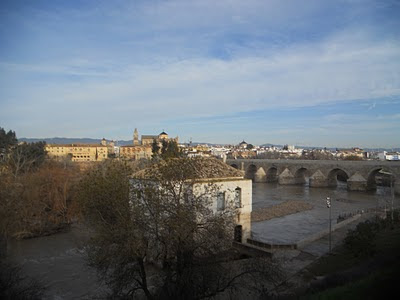Córdoba.
Lejana y sola.
Lejana y sola.
Jaca negra, luna grande,
y aceitunas en mi alforja.
Aunque sepa los caminos
yo nunca llegaré a Córdoba.
y aceitunas en mi alforja.
Aunque sepa los caminos
yo nunca llegaré a Córdoba.
Por el llano, por el viento,
jaca negra, luna roja.
La muerte me está mirando
desde las torres de Córdoba.
jaca negra, luna roja.
La muerte me está mirando
desde las torres de Córdoba.
¡Ay qué camino tan largo!
¡Ay mi jaca valerosa!
¡Ay, que la muerte me espera,
antes de llegar a Córdoba!
¡Ay mi jaca valerosa!
¡Ay, que la muerte me espera,
antes de llegar a Córdoba!
Córdoba.
Lejana y sola.
Lejana y sola.
Federico Garcia Lorca was perhaps the greatest Spanish poet and dramatist of the twentieth century. Canción del jinete, which he published as part of a collection called Canciones in 1924, depicts a horseman (jinete) on the road to Córdoba. "Even though I know the way," the horseman says, "I will never reach Córdoba" (lines 5-6). Looking back, it's almost as if Lorca was predicting his own demise. It is thought that he was executed by the Nationalists (which would win the Civil War, lead by Francisco Franco) and his body dumped somewhere in the Sierra Nevada, but no one really knows for sure. Lorca was quite avant-garde for his time, exploring such themes as sexuality, criticism of the Church and society, and gender roles. Adding credence to the execution-by-Nationalists hypothesis is that Franco went on to ban Lorca's work for nearly fifteen years after the end of the Guerra Civil, and then only permitted the release of censored editions. At any rate, what is known is that Lorca was arrested on August 18th, 1936 and was never seen again, cutting tragically short one of the most promising careers in literary history.
Canción del jinete is my favorite poem by Lorca, so I was especially looking forward to our excursion to Córdoba.
But Córdoba is much more than the scene for a famous poem; it was once the capital of both the Arab and Roman holdings in Spain. Soon after the Arab conquest of Spain began in 711, Córdoba was made a provincial capital (named Qurtuba) and later, a caliphate that encompassed most of modern-day Spain. At the height of its splendor, Córdoba was the largest city in the world and perhaps the most civilized in all of Europe. The centerpiece of the city is the incredible Catedral-Mezquita, or Cathedral-Mosque.
 |
| A file photo, because there's really no way to get a picture of the outside from ground level. |
The Great Mosque, as it was called, was built on the site of St. Vincent's Church (which the Visigoths constructed on top of a Roman temple). When the Moors arrived, they used half the church for themselves and allowed Christians to use the other half. The emir actually purchased the Christian half and began construction on the mosque in 784 and reached its current dimensions in 987. It soon became one of the most important sites of prayer in the Muslim world. In 1236, however, the Reconquista, or Reconquest, of Spain reached the stronghold of Córdoba, and the monarchs began slowly converting the mosque back into a church, culminating in the planting of a Renaissance cathedral right in the middle of the former mosque. The result was an incredible dichotomy of Arab and Christian architecture.
The Cathedral-Mosque is absolutely incredible. Incredibly massive, and filled with magnificent architecture and metal work. The director of the center kept talking about how horrible it was to put a giant cathedral of a different architectural style into a mosque, how it was a mistake and shouldn't have happened. But I take issue with that on two points. First, the Cathedral-Mosque is absolutely unique in its mix of Arab and Christian worship space (although it is now all part of the Cathedral of Córdoba), and as such makes it a fascinating place to visit. Second, it is thought that the church placed in the middle of the former Great Mosque probably saved the structure from destruction during the Spanish Inquisition. A remarkable place, nonetheless.
After the cathedral, I went exploring the city with another guy from our group. The center of the city is a really neat place, filled with relatively modern buildings and plenty of shops.
We were in search of one thing in particular: salmorejo.
Salmorejo is the Cordoban take on gazpacho, the famous cold tomato-based Spanish soup. Here, it's a cream of tomatoes, bread, garlic, oil, and vinegar, served with bits of jamon Serrano. Delicious, and pairs nicely with the local brew, the ubiquitous Cruzcampo. We met up with some more of our group afterwards, and grabbed a postre (dessert) at one of the dozens of pastry shops lining the streets of Córdoba.
Absolutely delicious. An excellent end to a great day trip. Until next time.








No comments:
Post a Comment